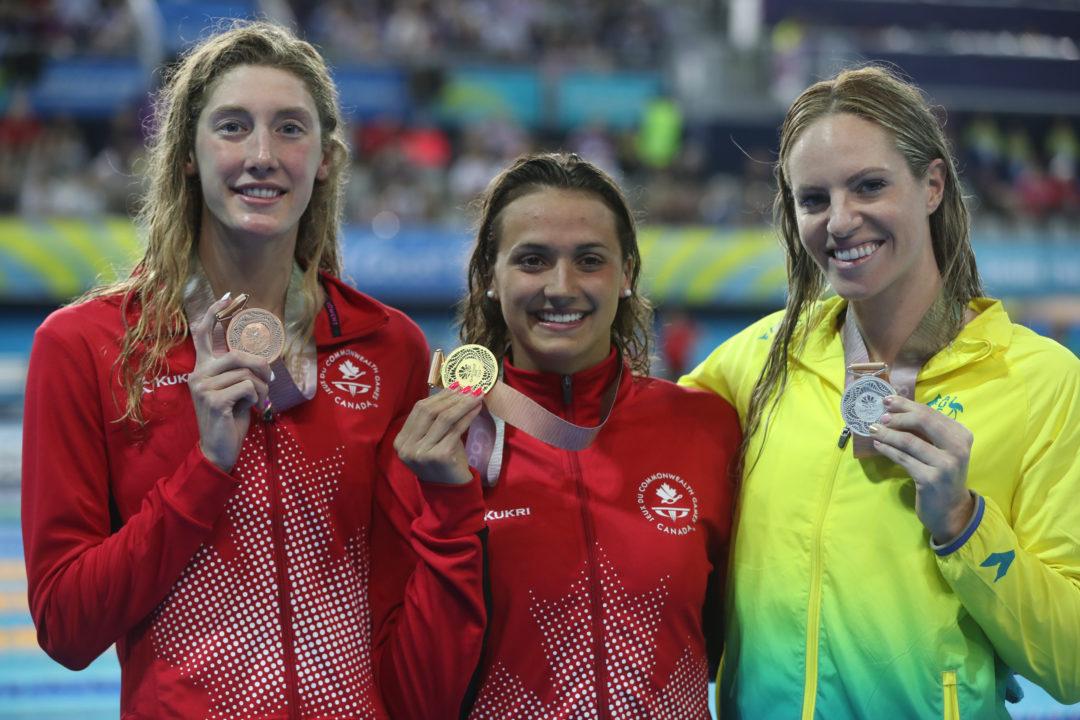TritonWear and SwimSwam bring you the best in swimming race analysis for the 2018 Commonwealth Games. With the power of TritonWear, you can access 12+ metrics for all athletes simultaneously, display the results in real-time to unlimited screens on deck, and review later in an easy to use interface for monitoring progress and identifying trends over time. See all Tritonwear Race Analysis here.
The women’s 100m backstroke was a thrilling event, right from the prelims. Australia’s
defending champion Emily Seebohm broke her own record by almost half a second before
Canada’s Kylie Masse lowered the record time even further in the next heat. Their race in the
final did not disappoint; Seebohm’s time matched Masse’s earlier record, but Masse finished
0.03 seconds faster, breaking the record twice in one day.
It was an extremely tight race between Masse and Seebohm from the start. Seebohm took an
early lead with her powerful underwater kicks, breaking out slightly ahead of Masse.
They both swam at the same speed, but had different stroking metrics (DPS, stroke rate, stroke
index).
On the first 50m, Masse was pulling faster but less efficient strokes, producing low DPS at a
faster rate. Conversely, Seebohm was taking longer and more efficient strokes but took more
time with each stroke. Their opposite strategies had them right beside one another through the
lap, but Seebohm’s faster turn gave her an added advantage that put her three hundredths of a
second ahead off the wall.
The second lap had an interesting turn of events. Masse and Seebohm were still neck-and- neck
but both reversed their stroking strategy. Masse slowed down her strokes significantly and
pulled at a slower rate than Seebohm, but supplemented this with an increase in her DPS.
Meanwhile, Seebohm slightly increased her stroke rate, but had a large drop in DPS, registering
a lower DPS and stroke index than Masse. The loss of stroke efficiency was evident in her
increased stroke count, going up from 32 strokes on the first half to 40 coming back.
Key Takeaways
This race demonstrates the importance of maximizing DPS and stroke efficiency, especially in
sprint events where each stroke can determine the outcome of the race. They employed
opposite strategies, but between Masse and Seebohm, it was the athlete who produced more
efficient strokes and gained more distance with each stroke that clocked in the faster split in
either lap.
To dive into the numbers of each athlete yourself, use the interactive board below to see exactly
how they performed across all metrics.
Stay tuned for more race analysis!
VISIT THE TRITONWEAR HQ
LIKE TRITONWEAR ON FACEBOOK
FOLLOW TRITONWEAR ON TWITTER
FOLLOW TRITONWEAR ON INSTAGRAM
Swimming analysis is courtesy of Tritonwear, a SwimSwam partner.


Thought Masse would go 57 this year. Looks like the Americans have a shot to pass her up this year.
Im inclined to think the fact the pool is outdoors would be hindering on her time… She was 58.5 in season a couple months ago. I think Pan Pacs we will see 57.8 from her.
Regan Smith vs Taylor Ruck (the junior rematch) and Kathleen Baker vs Emily Seebohm vs Kylie Masse will be fun to watch
As previously posted, possibly another factor to consider re. Masse’s swim (in addition to competing in an outdoor pool — she trains indoors) is that, just like many other college/university students, she is in the middle of final exams and probably had to write her finals early or have them deferred (likely a bit stressful for her and other swimmers in similar situations).